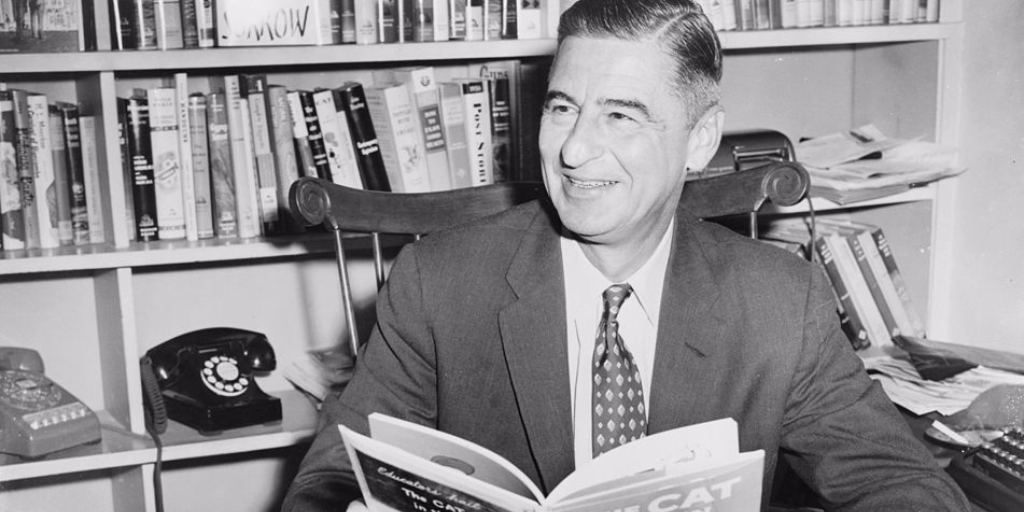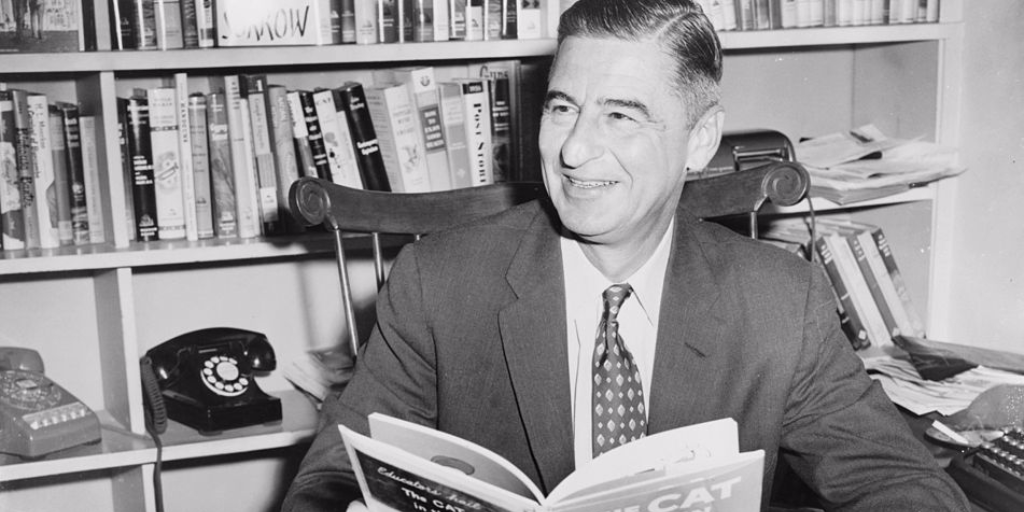Say hello to Dr. Seuss, a rhymer of rhymes both tight and loose. A BRI favorite he really is; the following story is really his.

Vital Stats
Born: March 2, 1904
Died: September 25, 1991, age 87
Real Name: Theodore Seuss Geisel
- He adopted “Seuss” as his writing name during Prohibition, while attending Dartmouth College. The reason: He was caught with a half-pint of gin in his room and was told to resign as editor of the college humor magazine as punishment. Instead, he just stopped using Geisel as a byline.
- Years later, he added “Dr.” to his name “to sound more scientific.” He didn’t officially become a doctor until 1956, when Dartmouth gave him an honorary doctorate.
Career Stats
Accomplishments: He wrote 48 books, selling more than 100 million copies in 20 languages. (Including four of the top 10 bestselling hardcover children’s books of all time: The Cat in the Hat, Green Eggs and Ham, Hop on Pop, and One Fish, Two Fish, Red Fish, Blue Fish.)
- As a filmmaker, he won three Oscars—two for documentaries made in the 1940s (Hitler Lives, about Americans troops, and Design for Death, about Japanese warlords), and one in 1951 for animation (Gerald McBoing-Boing). By that time, he had written four kids’ books and turned down Hollywood screenplay offers in order to keep writing them.
- In 1984 he won the Pulitzer Prize for his contribution to children’s literature. Flops: Only one—a novel called The Seven Lady Godivas, an “utterly ridiculous retelling of the story of Lady Godiva” that was first published in 1937 and republished 40 years later. He always wanted to write The Great American Novel…but the book bombed in 1977, too.
How He Got Started
He was working as a cartoonist in the late 1920s for Judge magazine. One of his cartoons “showed a knight using Flit insecticide to kill dragons.” Someone associated with Flit’s ad agency (McCann-Erikson) saw the cartoon and hired Geisel. For the next 10 years he created ads for Flit and other Standard Oil products. His greatest claim to fame at the time: a well-known ad phrase, “Quick Henry, the Flit!”
His contract with McCann-Erikson allowed him to write and publish books for kids, so he wrote To Think That I Saw It on Mulberry Street. It was turned down by 27 publishers. Said Seuss: “The excuse I got for all those rejections was that there was nothing on the market quite like it, so they didn’t know whether it would sell.” Vanguard Press finally picked it up in 1937, and it was an immediate success. So he quit the ad agency and began writing kids’ books full-time.
How He Got His Ideas
“The most asked question of any successful author,” Seuss said in 1989, “is ‘How do you get your ideas for books?’ ” Over the years he did reveal a number of his inspirations:
Horton Hatches the Egg
“Sometimes you have luck when you are doodling. I did one day when I was drawing some trees. Then I began drawing elephants. I had a window that was open, and the wind blew the elephant on top of the tree; I looked at it and said, ‘What do you suppose that elephant is doing there?’ The answer was: ‘He is hatching an egg.’ Then all I had to do was write a book about it. I’ve left that window open ever since, but it’s never happened again.”
Green Eggs and Ham
- Bennett Cerf, the founder and publisher of Random House, bet Geisel $50 that he couldn’t write a book using just 50 words.
- Geisel won the bet. “It’s the only book I ever wrote that still makes me laugh,” he said 25 years later. He added: “Bennett never paid!”
The Lorax
Dr. Seuss’s favorite book, he said, “is about people who raise hell in the environment and leave nothing behind.” He wrote the story on a laundry list as he sat at a hotel pool in Kenya, watching a herd of elephants with his wife. “I wrote it as a piece of propaganda and disguised the fact,” he told a reporter. “I was on the soapbox. I wasn’t afraid of preaching—but I was afraid of being dull.”
Yertle the Turtle
“Yertle the Turtle is Adolf Hitler.”
The Cat in the Hat
- In the early 1950s, novelist John Hersey was on a panel that analyzed how reading was taught in a Connecticut school system. In May 1954, Life magazine published excerpts of the panel’s report (called “Why Do Students Bog Down on the First R?”). In it, Hersey wrote that one of the major impediments to learning was the dull “Dick and Jane” material students were given—especially the illustrations. Kids, he said, should be inspired with “drawings like those wonderfully imaginative geniuses among children’s illustrators, Tenniel, Howard Pyle, Dr. Seuss.”
- A textbook publisher read the article and agreed. He contacted Dr. Seuss and asked him to create a reading book. The publisher sent Seuss a list of 400 words and told him to pick 220 to use in the book. The reason: People felt this was the maximum that “kids could absorb at one time.”
- “Geisel went through the list once, twice and got nowhere,” reports Parents magazine. “He decided to give it one more shot; if he could find two words that rhymed, they’d form the title and theme of the book. Within moments, cat and hat leaped off the page. But then it took him 9 months to write the entire book.”









